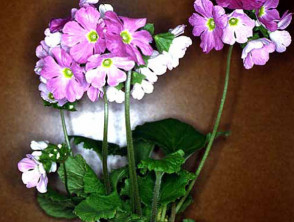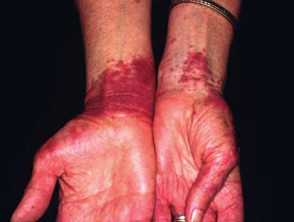| Common name: | Round leaved primula, Primrose, the poison primrose. |
| Botanical name: | Primula obconica |
| Family: | Primulaceae |
| Origin: | Primulaceae are mainly distributed in central and south-west China where they grow in calcareous soils at altitudes of 800–2000 m. Primula obconica was first introduced to Britain from Yichang (Ichang) County, China, in 1880 and rapidly became established worldwide as a popular ornamental house-plant. |
| Description: | A perennial herb whose leaves are basal, simple, elongated, and with glandular hairs. Flowers are terminal on a naked stem, 5-parted, funnel-shaped, pale lilac or purple with a yellow eye. Fruit is a capsule. A German horticulturist, successfully breed a primin-free Primula obconica cultivar but unfortunately the flowers were much less spectacular. |
| Uses: | Ornamental plant. |
| Allergens: | The main allergens are: primin (2-methoxy-6-pentyl-1,4-benzoquinone), primetin, miconidin (2-methoxy-6-pentyl-1,4-dihydroxybenzene) and possibly quinones. The allergens appear to be concentrated in the glandular hairs on leaves and stems. Sixteen of 82 species of the Primulaceae family which were investigated by the Craven screening test were found to contain primin, The amount of primin is determined by origin, temperature, light, moisture, manuring, soil pH (content of lime), habitat and season, etc. |
| Allergy: | Allergic contact dermatitis. The first accounts incriminating Primula obconica as a cause of dermatitis were published in horticultural journals in the 19th century. So numerous were the papers that it was predicted in 1899 that such a poisonous plant would be grown less and less frequently, but this prophecy has not been fulfilled. In 1906, the plant was termed the ‘fatted calf of Harley Street’. Primula remained the commonest cause of plant dermatitis in Great Britain until the 1960s. |
| Cross reactions: | Other primulaceae. The finding of primin in P. praenitens, P. eliator spp eliator, P. veris (syn. P. officinalis) appears to explain occasional reports of dermatitis, from these species e.g. cowslip (P. veris). |
| Other information: | The various species of Primula can be divided into four groups according to the odour of the root when injured. The odours resemble anise (Pimpinella), methyl salicylate and the disagreeable odour of bed bugs. A fourth group has no odour. Primula obconica belongs to the methyl salicylate group. |
| Patch test: | Primin. The first patch test to primula was performed in 1890! |

